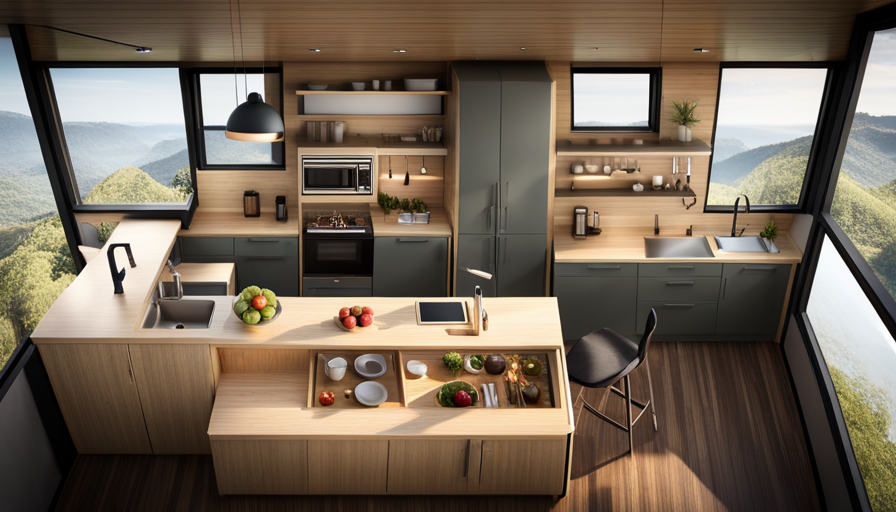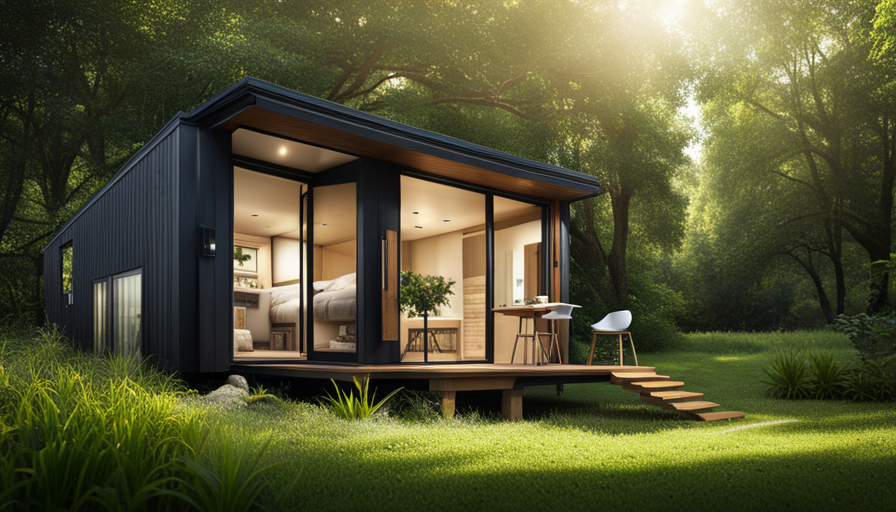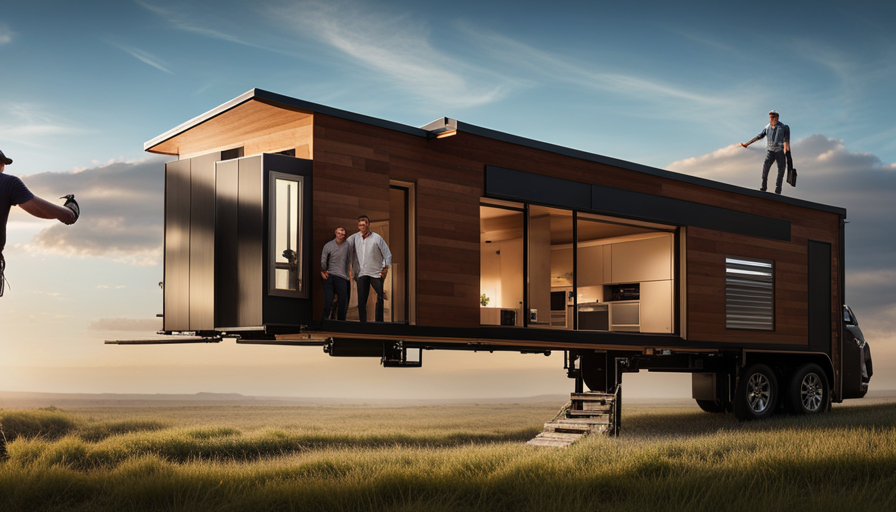In an era dominated by vast mansions and opulent estates, there’s an undeniable allure in the modesty and allure of a tiny house. Much like a subtle bloom emerging from a crevice in the pavement, these small homes represent a defiance towards extravagance and a shift back to the fundamental aspects of living. You might wonder, how do these tiny homes function? Get ready to be fascinated as we explore the intricate details of how these small wonders operate.
From their ingenious design and construction to their space-maximizing solutions, tiny houses are a testament to human ingenuity and creativity. They embrace the concept of minimalism and challenge us to reevaluate our relationship with material possessions. But it doesn’t end there; tiny houses also offer the possibility of off-grid living, utilizing sustainable energy sources and innovative plumbing and water systems.
Join me on this journey of discovery as we explore the inner workings of tiny houses, uncovering their benefits, challenges, and tips for transitioning to a tiny house lifestyle. Get ready to be inspired, because the world of tiny houses is about to open up before your very eyes.
Key Takeaways
- Tiny houses utilize limited space and clever design for a cozy and functional living environment.
- Understanding zoning regulations is important when building a tiny house.
- Tiny houses can be more affordable housing options compared to traditional homes.
- Designing a tiny house poses unique challenges due to limited space.
Understanding the Concept of Tiny Houses
Tiny houses work by utilizing limited space and clever design to create a cozy and functional living environment. Understanding zoning regulations is an important part of the process when it comes to building a tiny house. These regulations vary from place to place, so it’s crucial to research and understand the specific requirements in your area.
Some areas may have restrictions on the size of the house, while others may require it to be built on a foundation or have certain utilities in place. It’s also important to consider the financial aspects of living in a tiny house. While they can be a more affordable housing option compared to traditional homes, there are still costs involved. Expenses like land, materials, and permits need to be taken into account.
Additionally, it’s important to consider the ongoing costs of living in a tiny house, such as utilities and maintenance. Understanding these financial considerations will help you plan and budget effectively. Moving on to the next section about the design and construction of tiny houses, it’s important to consider the layout and materials used in order to maximize space and create a comfortable living environment.
Design and Construction of Tiny Houses
To understand the design and construction of tiny houses, you need to first consider the space-saving techniques and creative solutions that are utilized. Here are three key aspects to consider:
-
Design Challenges: Designing a tiny house poses unique challenges due to limited space. Every square inch must be carefully planned and optimized to ensure functionality without compromising comfort. Architects and designers must think outside the box to create innovative layouts that maximize the available space while maintaining a sense of openness.
-
Cost Considerations: Building a tiny house is often more cost-effective compared to traditional homes. However, there are still important cost considerations to keep in mind. Materials must be chosen wisely, balancing affordability with durability. Additionally, efficient use of space can help reduce construction costs by minimizing the overall square footage.
-
Maximizing Space and Storage Solutions: One of the most crucial aspects of tiny house design is maximizing space and storage solutions. Every nook and cranny must be utilized effectively. From multifunctional furniture to clever storage compartments, creative solutions are essential to make the most of the limited space available.
Understanding the design and construction of tiny houses requires careful consideration of design challenges and cost considerations. By focusing on maximizing space and storage solutions, tiny house dwellers can create homes that are both functional and efficient.
Maximizing Space and Storage Solutions
Get ready to discover the genius ways you can maximize space and storage solutions in your tiny house! When it comes to living in a small space, every square inch counts. That’s why it’s important to get creative with your storage solutions and make the most of the space you have. Here are some ideas to help you make the most of your tiny house:
| Maximizing Space | Creative Storage |
|---|---|
| Use multi-functional furniture such as a sofa that can be converted into a bed or a dining table that can be folded away when not in use. | Utilize vertical space by installing shelves or hooks on the walls to store items such as books, kitchen utensils, or clothing. |
| Incorporate built-in storage solutions, such as cabinets or drawers under the stairs or in the walls. | Opt for furniture with hidden storage compartments, such as ottomans or coffee tables with storage space inside. |
| Choose furniture that can be easily moved or rearranged to create different layouts and maximize space. | Use storage containers or baskets to keep items organized and easily accessible. |
By implementing these space-saving and storage solutions, you can make the most of your tiny house and create a functional and organized living space. In the next section, we will explore the topic of off-grid living and sustainable energy sources, which is essential for tiny house dwellers looking to live a more environmentally friendly lifestyle.
Off-Grid Living and Sustainable Energy Sources
Experience the freedom and self-sufficiency of off-grid living in your tiny home by exploring sustainable energy sources that’ll power your lifestyle. Off-grid power systems are essential for those seeking to live off the grid and reduce their environmental impact.
Here are three sub-lists that delve deeper into this topic:
-
Solar Power: Utilizing solar panels is a popular choice for tiny house owners. This eco-friendly option harnesses the sun’s energy and converts it into electricity. By installing solar panels on your tiny home’s roof, you can generate clean and renewable energy to power your appliances and lighting.
-
Wind Power: Another sustainable energy source for off-grid living is wind power. Installing a small wind turbine can generate electricity by harnessing the power of the wind. This option works best in areas with consistent wind patterns and can be a reliable backup to solar power.
-
Micro-Hydro Power: If you live near a stream or river, micro-hydro power can be an excellent option for off-grid energy. By utilizing the flow of water, a micro-hydro system can generate electricity. This system requires careful planning and installation, but it can provide a consistent and reliable source of power.
By incorporating these off-grid power systems into your tiny home, you can embrace eco-friendly living while enjoying the benefits of self-sufficiency.
Now, let’s transition to the next section about plumbing and water systems in tiny houses.
Plumbing and Water Systems in Tiny Houses
Living off-grid in a tiny home means finding inventive ways to handle plumbing and water systems. In a tiny house, space is at a premium, so the plumbing system needs to be compact and efficient. Tiny house plumbing typically involves using small pipes and a simplified layout to minimize the amount of space needed.
Water can be sourced from various places, such as rainwater collection systems, wells, or even nearby streams. To conserve water, many tiny house owners use low-flow fixtures and composting toilets. These toilets use little to no water and instead turn waste into compost, making them an eco-friendly option. Additionally, greywater systems are often utilized to recycle water from showers and sinks for tasks like watering plants or flushing toilets.
When it comes to heating and cooling options for tiny houses, there are several choices available. From energy-efficient wood stoves and propane heaters to solar-powered air conditioning units and portable fans, there are options to suit different climates and preferences. Transitioning into the subsequent section, heating and cooling in tiny houses is just as important as managing the plumbing and water systems.
Heating and Cooling Options for Tiny Houses
Now that we’ve covered the plumbing and water systems in tiny houses, let’s delve into the topic of heating and cooling options. When it comes to maintaining a comfortable temperature in a tiny house, there are a few key options to consider.
One popular choice for heating and cooling in tiny houses is mini split systems. These systems consist of an outdoor compressor unit and one or more indoor units that distribute the conditioned air. They’re compact, energy efficient, and offer both heating and cooling capabilities. Additionally, they can be controlled independently for different zones within the tiny house, providing personalized comfort.
Another option to consider, especially for those looking for eco-friendly alternatives, is solar-powered cooling. Solar air conditioners utilize the sun’s energy to power the cooling process, reducing dependency on traditional electricity. These systems often work in conjunction with solar panels, making them a sustainable and cost-effective choice for tiny house owners.
With efficient heating and cooling systems in place, you can ensure a comfortable living environment in your tiny house, regardless of the weather outside.
Now, let’s move on to the next section and explore furniture and decor for small spaces.
Furniture and Decor for Small Spaces
When it comes to furnishing and decorating small spaces, finding creative solutions can transform cramped quarters into stylish and functional areas. Here are three key tips for furniture selection and organization in tiny houses:
-
Multi-purpose furniture: Look for furniture pieces that serve multiple functions. For example, a sofa that can be converted into a bed or a coffee table with built-in storage compartments. This allows you to maximize the use of limited space while still having all the necessary furniture.
-
Vertical storage: Utilize vertical space by installing shelves, hooks, and hanging organizers on walls. This not only saves floor space but also keeps your belongings organized and easily accessible. Consider using wall-mounted cabinets or floating shelves to store items such as books, kitchen supplies, or decorative items.
-
Foldable and collapsible furniture: Invest in furniture that can be easily folded or collapsed when not in use. This includes folding tables, chairs, and even beds. These versatile pieces can be stored away to free up space for other activities during the day.
By carefully selecting furniture and incorporating smart organization tips, you can make the most of your tiny house.
In the next section, we’ll explore the benefits of living in a tiny house, highlighting how it can bring simplicity and sustainability to your life.
Benefits of Living in a Tiny House
With the compact living spaces of tiny houses, I can embrace a minimalist lifestyle and experience the multitude of benefits it brings. Living minimally not only means having fewer possessions, but also having a smaller environmental footprint. By downsizing, I reduce my consumption of resources and minimize waste. This allows me to live a more sustainable and eco-friendly lifestyle, which is important to me.
One of the biggest advantages of living in a tiny house is the financial freedom it offers. With lower costs for construction, maintenance, and utilities, I can save a significant amount of money. This financial freedom allows me to pursue my passions, travel, or invest in experiences rather than material possessions. It also reduces the financial stress and burden that often comes with traditional homeownership.
In order to evoke emotion and provide a visual representation of the benefits of minimalist living, I have created a table below.
| Benefits of Minimalist Living | Emotional Impact |
|---|---|
| Less Clutter | Calm and Peaceful |
| Lower Expenses | Financial Security |
| Environmental Sustainability | Sense of Purpose |
| More Freedom | Happiness and Fulfillment |
Living in a tiny house is not without its challenges and considerations, but the benefits far outweigh them. Transitioning to the next section, it is important to understand the potential obstacles that come with tiny house living.
Challenges and Considerations of Tiny House Living
Imagine the challenges and considerations you’ll face when embracing the minimalist lifestyle of living in a tiny house. While the idea of downsizing and simplifying can be appealing, it’s important to be aware of the potential difficulties that come with tiny house living.
One challenge is the limited space. With less square footage available, you’ll need to carefully plan and organize your belongings to maximize efficiency. Additionally, you’ll have to adjust to a smaller living area, which may require creative solutions for storage and multi-functional furniture.
Another consideration is the lack of privacy. In a tiny house, there are fewer rooms and walls to separate different areas, which can make it challenging to find personal space. Noise can also be an issue, as sound carries more easily in a small space.
Furthermore, living in a tiny house requires a significant mindset shift. You must be willing to let go of material possessions and embrace a simpler way of life.
Despite these challenges and considerations, transitioning to a tiny house lifestyle can be rewarding and fulfilling. With careful planning and adjustment, you can create a cozy and functional space that meets your needs and allows you to focus on what truly matters.
Tips for Transitioning to a Tiny House Lifestyle
Are you ready to embark on the adventure of transitioning to a minimalist lifestyle in a tiny home? The decision to downsize and live in a tiny house comes with its own set of challenges, but with careful planning and preparation, it can be a rewarding experience.
Here are some tips to help you make a smooth transition to a tiny house lifestyle.
Firstly, it’s important to mentally prepare yourself for the change. Understand that you’ll be living in a smaller space and will need to let go of unnecessary possessions. This can be a difficult process, but it’s essential for creating a clutter-free living environment.
Next, focus on maximizing storage space. Utilize every inch of your tiny home by investing in multi-functional furniture and storage solutions. Think creatively and find ways to make the most out of your limited space.
Additionally, embrace a minimalist mindset. Learn to prioritize experiences over material possessions and simplify your life. This can involve decluttering regularly, being mindful of your purchases, and learning to live with less.
Lastly, stay organized and maintain a routine. With limited space, it’s crucial to keep things tidy and have a designated place for everything. Establishing a routine can help you stay on top of chores and prevent your tiny home from becoming chaotic.
Transitioning to a tiny house lifestyle may have its challenges, but with these downsizing tips, you can successfully embrace minimalism and enjoy the freedom that comes with living in a tiny home.
Frequently Asked Questions
How much does it cost to build a tiny house?
Building a tiny house can be a cost-effective alternative, with an average cost of around $20,000 to $40,000. However, the cost considerations depend on various factors such as location, size, and the materials used.
When it comes to building materials, opting for sustainable and recycled materials can help reduce costs. Additionally, DIY enthusiasts can save money by doing the construction themselves.
It’s important to carefully plan and budget to ensure the overall cost stays within your means.
Are there any restrictions or regulations on where you can park a tiny house?
Zoning laws and parking regulations determine where you can park a tiny house. These laws vary depending on the location, so it’s important to research and understand the specific regulations in your area.
Zoning laws may restrict where you can place a tiny house based on the type of land it’s built on, while parking regulations may dictate the size and type of vehicle allowed on certain properties. Compliance with these regulations is crucial to avoid legal issues.
What are the maintenance requirements for a tiny house?
To maintain a tiny house, cleaning and repairs are crucial.
Cleaning can be a calming chore, clearing clutter and dusting diligently. Repairs ensure a cozy abode, fixing leaks, squeaky hinges, or faulty electricals. Regular inspections help catch issues early.
Cleaning involves scrubbing surfaces, vacuuming carpets, and organizing storage spaces. Repairs may include patching up walls, fixing plumbing, or replacing worn-out appliances.
Tiny house maintenance requires dedication and attention to detail, ensuring a well-functioning and inviting home.
Can you have pets in a tiny house?
Having pets in a tiny house can be a rewarding experience, but it also comes with its challenges. Some tips for making a tiny house pet-friendly include ensuring there’s enough space for your pet to move around comfortably, providing them with proper exercise and mental stimulation, and creating designated areas for their food, water, and litter.
However, it’s important to consider the pros and cons of having pets in a tiny house. One of the main drawbacks is limited space, which can make it difficult for both you and your pet to have enough room to live comfortably. Additionally, having a pet in a small space can lead to increased mess, as there may not be as much room for them to roam and play without knocking things over or making a mess.
Overall, while it is possible to have pets in a tiny house, it’s important to carefully consider the challenges and limitations that come with it.
What are the financing options available for purchasing a tiny house?
Tiny house financing options are as abundant as the stars in the sky. From traditional banks to specialized lenders, the world is your oyster when it comes to securing a loan for your dream tiny home. Whether you choose a fixed-rate mortgage or an adjustable-rate mortgage, there is a financing option that will suit your needs.
So don’t let the size of your dream hold you back, because with the right loan, the sky’s the limit!
Conclusion
In conclusion, after delving into the world of tiny houses, it’s clear that they’re not just a passing trend, but a viable and sustainable housing option. By utilizing smart design and construction techniques, tiny houses are able to maximize space and storage solutions, offering a comfortable living environment.
Furthermore, off-grid living and sustainable energy sources can be incorporated, making tiny houses not only environmentally friendly but also cost-effective. While there are challenges and considerations to living in a tiny house, with proper planning and organization, this lifestyle can bring numerous benefits.
So, if you’re ready to downsize and simplify your life, transitioning to a tiny house may just be the perfect choice for you.
Hi, I’m Emma. I’m the Editor in Chief of Tiny House 43, a blog all about tiny houses. While tree houses are often associated with childhood, they can be the perfect adult retreat. They offer a cozy space to relax and unwind, surrounded by nature. And since they’re typically built on stilts or raised platforms, they offer stunning views that traditional homes simply can’t match. If you’re looking for a unique and romantic getaway, a tree house tiny house might just be the perfect option.










